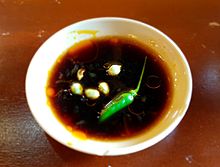Siling labuyo
| 'Siling Labuyo' | |
|---|---|
 'Siling Labuyo' pepper. The small triangular fruits of siling labuyo are distinctively borne pointing upwards, like other Capsicum frutescens cultivars. | |
| Genus | Capsicum |
| Species | Capsicum frutescens |
| Cultivar | 'Siling Labuyo' |
| Heat | |
| Scoville scale | 80,000 - 100,000 SHU |

Siling labuyo is a small chili pepper cultivar that developed in the Philippines after the Columbian Exchange. It belongs to the species Capsicum frutescens and is characterized by triangular fruits which grow pointing upwards.[1] The fruits and leaves are used in traditional Philippine cuisine. The fruit is pungent, ranking at 80,000 to 100,000 heat units in the Scoville Scale.[2]
The cultivar name is Tagalog, and literally translates to "wild chili."[1] It is also known simply as labuyo or labuyo chili.[3] It is also sometimes known as Filipino bird's eye, to differentiate it from the Thai bird's eye chili. Both are commonly confused with each other in the Philippines, though they are cultivars of two different species.[4] Siling labuyo is one of two common kinds of local chili found in the Philippines, the other being siling haba (a Capsicum annuum cultivar).[5]
Siling labuyo is listed in the Ark of Taste international catalog of endangered heritage foods of the Philippines by the Slow Food movement.[6]
Taxonomy and names
Siling labuyo is officially known under the cultivar name Capsicum frutescens 'Siling labuyo'. It belongs to the species Capsicum frutescens. Related cultivars to 'Siling labuyo' include 'Tabasco', 'Malagueta', and 'Peri-peri'.[1]
The common name is Tagalog for "wild chili", from sili ("chili") and the enclitic suffix -ng, and labuyo ("growing wild", also a term for wild chicken or junglefowl).[1][7] Other local names for it include chileng bundok, siling palay, pasitis, pasite (Tagalog), katumbal, kutitot, siling kolikot (Bisaya), sili ti diablo (Ilocano), lada, rimorimo (Bicolano), and paktin (Ifugao).[8]
Commonly confused cultivars

Red bird's eye chili are commonly mislabeled as siling labuyo in Philippine markets. But they are actually a chili pepper cultivar from a different species (Capsicum annuum) that came by way of Thailand. Their fruits, unlike C. frutescens, are borne on the plant drooping down.[4] In Luzon, siling tingala, a high-yield F1 hybrid of C. frutescens and C. annuum from Taiwan are also commonly sold as siling labuyo. While they have C. frutescens ancestry (the fruits are also borne erect), they are much longer and uniformly red, similar to Thai bird's eye chilis.[9]
Both the bird's eye chili and siling tingala are popular with retailers because their color and shape are more consistent and they have a longer shelf life, but they are regarded as less spicy than siling labuyo.[1][9][10]
Description
Like other Capsicum frutescens cultivars, siling labuyo has a compact habit, growing between 1 to 4 ft (0.30 to 1.22 m) high. They have smooth ovate to lanceolate leaves that are around 2.5 in (6.4 cm) in length with pointed tips. They produce small greenish-white flowers with purple stamens. These develop into a large number of small, tapering fruits that are around 0.6 to 1 in (1.5 to 2.5 cm) in length. The fruits are very pungent and are characteristically borne erect (pointing upwards). Immature fruits are deep green in color and usually ripen to a vivid red, but other varieties can have yellow, orange, white, purple, or even black fruits. Flowers and fruits are often clustered in groups of 2 to 3 at a node.[1][11][12]

Siling labuyo fruits are small but are very hot. It measures around 80,000-100,000 Scoville units which is at the lower end of the range for the hotter habanero chili.[2] At one time it was even listed as the hottest chili in the Guinness Book of World Records but other hotter varieties of chili have since been identified.
Ingredient in cooking
Although not as central in Filipino cuisine as bird's eye chilies are in other cuisines of Southeast Asia, it is still an often-used ingredient. The fruit of siling labuyo is popularly used to flavor vinegar to be used as a spicy condiment, while its leaves are usually consumed as a vegetable, such as in the dish tinola.[1][13]
See also
References
- ^ a b c d e f g DeWitt, D.; Bosland, P.W. (2009). The Complete Chile Pepper Book: A Gardener's Guide to Choosing, Growing, Preserving, and Cooking. Timber Press. ISBN 978-0881929201.
- ^ a b "2018 Scoville Scale: Ultimate List of Pepper's & Their Scoville Heat Units". Chasing Chilli. Retrieved 22 September 2018.
- ^ Loresco, Shadz. "'Superhots' spicing up PH chili industry". Rappler. Retrieved 22 September 2018.
- ^ a b "Siling Labuyo: The Filipino Bird's Eye". PepperScale.
- ^ Frial-McBride, Mary Grace (2016). "Extraction of resins from Capsicum annuum var. longum (Siling haba) for the study of their potential anti-microbial activities" (PDF). Journal of Chemical and Pharmaceutical Research. 8 (3): 117–127. ISSN 0975-7384. S2CID 41092438. Retrieved 24 March 2018.
- ^ "Siling Labuyo". Slow Food Foundation for Biodiversity. Retrieved 19 December 2018.
- ^ "labuyo". Tagalog-Dictionary.com. Retrieved 4 February 2019.
- ^ Capsicum Frutescens Linn. Sileng-Labuyo
- ^ a b Salcedo, Margaux (31 July 2016). "Slow Food campaign kicks into high gear in PH". Inquirer Business. Retrieved 27 February 2019.
- ^ Connie Veneracion (16 January 2016). "Correction: "siling labuyo" is not the same as bird's eye chili". CasaVeneracion. Retrieved 4 February 2017.
- ^ "Siling-labuyo". Philippine Medicinal Plants. Retrieved 4 February 2017.
- ^ "Hot pepper" (PDF). Republic of Philippines, Department of Agriculture. Retrieved 3 June 2014.
- ^ Nagpala, Ellaine Grace. (2007). A fresh look at siling labuyo. BAR Chronicle 8(10). Retrieved 2009-10-22.
External links
 Media related to Capsicum frutescens 'Siling Labuyo' at Wikimedia Commons
Media related to Capsicum frutescens 'Siling Labuyo' at Wikimedia Commons
